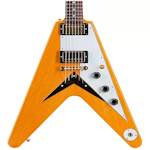
The Gibson Flying V is a distinctive electric guitar known for its V-shaped body design. The design was the brainchild of then-Gibson president Ted McCarty, in an effort to update, modernize and generate interest in Gibson electric guitars. In the late 1950s, futuristic styling abounded and Gibson looked for ways to capitalize on it. In this article we cover the history of the Gibson Flying V.
- Introduction in the 1950s:
- The Gibson Flying V was introduced in 1958 as part of Gibson's Modernistic series, along with the Explorer and the Moderne.
- The design was unconventional and futuristic for its time, featuring a V-shaped body with sharp angles and a pointed headstock.
- Popular in automotive design at the time were pointed tailfins, which the guitar shape echoed.
- Initial Reception:
- The initial reaction to the Flying V was mixed. Some players found the design too radical, while others appreciated its unique and edgy look.
- The shape made playing in a sitting position difficult; a rubberized strip added on the edge of the lower bout aimed with limited success to solve it. Most players opted to rest the crotch of the V over the thigh when seated.
- Despite its innovative design, the Flying V initially struggled to gain popularity, and, after production of just under 100 units, was discontinued in 1959.
- Resurgence in the 1960s:
- In the late 1960s, the Flying V gained popularity among rock and blues players, and its distinctive shape became associated with the emerging hard rock and heavy metal genres.
- Guitarists such as Albert King and Lonnie Mack were among the early adopters of the Flying V, contributing to its growing reputation.
- Reissue and Reintroduction:
- Due to increasing demand, Gibson reintroduced the Flying V in the mid-1960s. However, production numbers were still relatively low compared to other Gibson models.
- In the 1970s, Gibson began reissuing the Flying V with slight modifications, and it started gaining more recognition.
- Popularity in the 1980s and Beyond:
- The 1980s saw a surge in popularity for the Flying V, especially among heavy metal guitarists. Iconic players like Dave Mustaine of Megadeth and Kirk Hammett of Metallica contributed to the guitar's popularity in the metal scene.
- Gibson produced various versions and signature models of the Flying V over the years, catering to different player preferences.
- Continued Legacy:
- The Flying V has continued to be a popular choice among guitarists across various genres, including hard rock, metal, blues, and even jazz.
- Gibson regularly releases new variations and limited-edition models of the Flying V to cater to the diverse tastes of modern players.
Here is a list of some prominent guitarists associated with the Flying V:
- Albert King: Often credited as one of the earliest adopters of the Flying V, Albert King was a blues guitarist who played a significant role in popularizing the guitar in the 1960s.
- Lonnie Mack: Another blues and rock guitarist, Lonnie Mack, played a pivotal role in the early popularity of the Flying V. His influential instrumental track "Memphis" showcased the guitar's capabilities.
- Dave Davies (The Kinks): Dave Davies, lead guitarist of the British rock band The Kinks, was known for his use of the Flying V. The distorted and raw sound of his guitar playing played a crucial role in shaping the band's early sound.
- Michael Schenker (UFO, Scorpions): German guitarist Michael Schenker gained fame for his work with UFO and the Scorpions. He often played a white Flying V, and his melodic yet powerful guitar work left a lasting impact on the hard rock and metal genres.
- Jimi Hendrix: While Jimi Hendrix is more commonly associated with his iconic Fender Stratocaster, he occasionally played a Flying V. His experimental and groundbreaking approach to the guitar transcended traditional boundaries.
- Andy Powell (Wishbone Ash): A founding member of the group widely acknowledged as the standard bearer of the "twin lead guitar" band configuration; seeing Powell without a Flying V would be like seeing Slash without his signature top hat.
- Rudolf Schenker (Scorpions): The rhythm guitarist and founding member of the Scorpions, Rudolf Schenker, is known for his extensive use of the Flying V, contributing to the band's signature sound.
- Kirk Hammett (Metallica): Kirk Hammett, lead guitarist for Metallica, has been associated with the Flying V throughout his career. His use of the guitar is particularly notable in the earlier years of Metallica's discography.
- Dave Mustaine (Megadeth): As the founder and lead guitarist of Megadeth, Dave Mustaine has often played various versions of the Flying V. The guitar has become synonymous with his aggressive and technical playing style.
- Zakk Wylde (Black Label Society, Ozzy Osbourne): Zakk Wylde is a highly influential guitarist known for his work with Ozzy Osbourne and as the frontman of Black Label Society. His use of the Flying V is prominent in his heavy, hard-hitting playing style.
- Joe Bonamassa: The blues guitarist, known for his vast collection of vintage electric guitars and amplifiers, has acquired several 1950s era Flying Vs and plays them regularly in live concerts.
These guitarists, among many others, have contributed to the Flying V's reputation as an instrument capable of producing a wide range of sounds across diverse musical genres.
The Gibson Flying V has become an iconic and enduring symbol in the world of electric guitars, appreciated for both its distinctive design and its contribution to the sound of numerous influential musicians.
